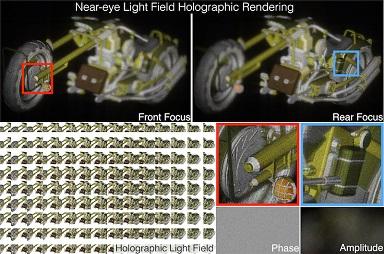Near-eye Light Field Holographic Rendering with Spherical Waves for Wide Field of View Interactive 3D Computer Graphics

Holograms have high resolution and great depth of field allowing the eye to view a scene much like seeing through a virtual window. Unfortunately, computer generated holography (CGH) does not deliver the same promise due to hardware limitations under plane wave illumination and large computational cost. Light field displays have been popular due to their capability to provide continuous focus cue. However, light field displays suffer from the trade offs between spatial and angular resolution, and do not model diffraction. We present a light field based CGH rendering pipeline allowing for reproduction of high-definition 3D scenes with continuous depth and support of intra-pupil view dependent occlusion. Our rendering accurately accounts for diffraction and supports various types of reference illumination for holograms. We prevent under- and over-sampling and geometric clipping suffered in previous work. We also implement point-based methods with Fresnel integration that are orders of magnitude faster than the state of art, achieving interactive volumetric 3D graphics. To verify our computational results, we build a see-through near-eye color display prototype with CGH that enables co-modulation of both amplitude and phase. We show that our rendering accurately models the spherical illumination introduced by the eye piece and produces the desired 3D imaginary at designated depth. We also derive aliasing, theoretical resolution limits, depth of field, and other design trade-off space for near-eye CGH.
Publication Date
Published in
Copyright
Copyright by the Association for Computing Machinery, Inc. Permission to make digital or hard copies of part or all of this work for personal or classroom use is granted without fee provided that copies are not made or distributed for profit or commercial advantage and that copies bear this notice and the full citation on the first page. Copyrights for components of this work owned by others than ACM must be honored. Abstracting with credit is permitted. To copy otherwise, to republish, to post on servers, or to redistribute to lists, requires prior specific permission and/or a fee. Request permissions from Publications Dept, ACM Inc., fax +1 (212) 869-0481, or permissions@acm.org. The definitive version of this paper can be found at ACM's Digital Library http://www.acm.org/dl/.
